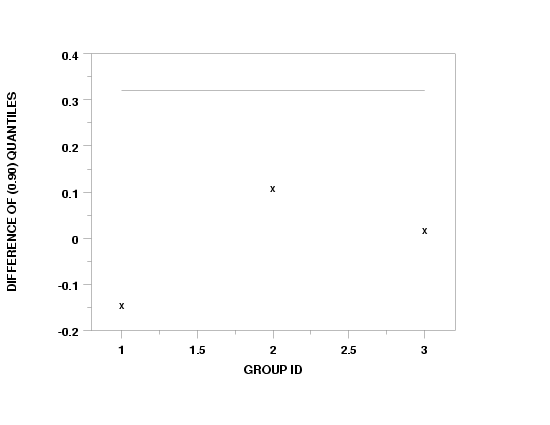

|
DIFFERENCE OF QUANTILEName:
Dataplot supports two methods for computing the quantile. The first method is based on the order statistic. The formula is:
where
NI1 = INT(q*(n+1)) NI2 = NI1 + 1 r = q*(n+1) - INT(q*(n+1)) An alternative method is called the Herrell-Davis estimate. This method attempts to provide a lower standard error for Xq by utilizing all the order statistics rather than a single (or a weighted average of two) order statistic. Note that there are caes where the Herrell-Davis has a substantially smaller standard error than the order statistic method. However, there are also cases where the reverse is true. To compute the Herrell-Davis estimate, do the following:
For the difference of quantiles, the quantile is computed for each of two samples then their difference is taken.
<SUBSET/EXCEPT/FOR qualification> where <y1> is the first response variable; <y2> is the first response variable; <par> is a parameter where the computed difference of the quantiles is stored; and where the <SUBSET/EXCEPT/FOR qualification> is optional.
LET A = DIFFERENCE OF QUANTILE Y1 Y2 SUBSET X > 1
where <value> is a number in the interval (0,1) that specifies the desired quantile.
Frank Herrell and C. E. Davis (1982), "A New Distribution-Free Quantile Estimator," Biometrika, 69(3), 635-640.
SKIP 25
READ IRIS.DAT Y1 TO Y4 X
.
LET XQ = 0.9
.
LET A = DIFFERENCE OF QUANTILE Y1 Y2
TABULATE DIFFERENCE OF QUANTILE Y1 Y2 X
.
XTIC OFFSET 0.2 0.2
X1LABEL GROUP ID
Y1LABEL DIFFERENCE OF (0.9) QUANTILE
CHAR X
LINE BLANK
DIFFERENCE OF QUANTILE PLOT Y1 Y2 X
CHAR X ALL
LINE BLANK ALL
BOOTSTRAP DIFFERENCE OF QUANTILE PLOT Y1 Y2 X
Dataplot generated the following output.

|
Privacy
Policy/Security Notice
NIST is an agency of the U.S.
Commerce Department.
Date created: 03/27/2003 | ||||||||||||||||||||